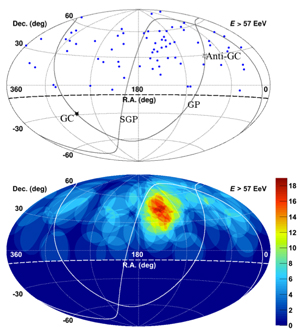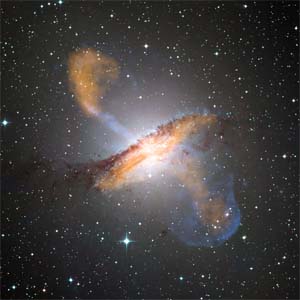A cluster of detections in the Northern Hemisphere sky might point to a source for the most energetic particles bombarding Earth's atmosphere.
Astronomers have found hints of a cosmic ray hotspot in the Northern Hemisphere sky. Cosmic rays are charged particles (mostly protons) that rain down on Earth from space. They reach energies far above those of manmade particle colliders, such as the Large Hadron Collider, which bashes protons together at trillions (1012) of electron volts.

J. Yang / NSF
Cosmic rays carrying energies less than 1015 electron volts come from inside the Milky Way, likely from its regions of rampant star birth and death. Those with even higher energies (up to about 60 exaelectron volts, or EeV — that’s 1018) come from outside our galaxy. Particles above 60 EeV generally don’t reach Earth, likely because they interact with other stuff during their journey across the vastness of intergalactic space and never make it to us.
It’s hard to tell exactly where most cosmic rays come from, because magnetic fields in our galaxy and outside it defect charged particles, masking their original incoming angles. Only the highest energy cosmic rays can shoot through the magnetic obstacle course without losing their sense of direction.
A study in 2007 of the incoming directions of the highest energy cosmic rays suggested a weak correlation with the locations of local active galactic nuclei (AGN), the blazing beacons created by voracious supermassive black holes as they gobble on gas in galactic cores. And in 2010 the same team, working with the Pierre Auger Observatory in Argentina, detected a “warm spot” in the direction of the active galaxy Centaurus A in the Southern Hemisphere sky.
Now, a separate team has detected a potential hotspot in the Northern Hemisphere sky. The region is centered at right ascension 9h 46.8m, declination 43.2°, between the legs of Ursa Major.
Finding a Cosmic Ray Cluster
The U.S.-Japanese collaboration used the Telescope Array, a network of more than 500 ping-pong-table-sized scintillation detectors in Utah. The detectors record impacts from secondary charged particles that are created when cosmic rays hit Earth’s atmosphere. These byproducts rain down in so-called air showers, and researchers use differences in the particles’ arrival times to back-calculate and determine the incoming direction of the original cosmic ray.

Telescope Array Collaboration
Over five years the Telescope Array team collected 72 events that met multiple detection and incoming angle criteria and also came from cosmic rays with energies of at least 57 EeV. As the data came in, the researchers saw a cluster growing in the direction of Ursa Major. So once they had enough data, they took a circle 40° wide and set it on their sky map, then slid it around in 1/10° increments. With each iteration, they counted up the number of events within the circle’s circumference.
Using this method, they found that they counted the highest number of events (19) when the circle was centered at the coordinates between the Great Bear’s legs.
Team member Gordon Thomson (University of Utah) explains that both previous research and merely eyeing the data suggested that 40° was the right size to use in teasing out this concentration. But because the astronomers didn’t expand or shrink the size of the circle and look for whether there was a drop-off at a certain radius, the team doesn’t know exactly how large the cluster is.
Pierre Auger cospokesperson Karl-Heinz Kampert (Bergische Universität Wuppertal, Germany) cautions that, without this analysis, the team’s hotspot is likely a bit overemphasized in the data. He’s also concerned that the collaboration didn’t do a blind analysis (i.e. they watched the cluster grow instead of waiting until they gathered all the data to look for patterns).
Having said that, he’s intrigued by the find and hopeful for what it portends. If both the Ursa Major and Cen A hotspots hold up to further analysis, it’ll mean that the highest energy cosmic rays detected in the Northern and Southern Hemispheres come from at least two different sources. “It’s really interesting data, but one has to be a bit more patient, I think, to make firm statements,” Kampert says.
Hotspot Cause(s) Still a Mystery

If the hotspots do prove to be real, the next question is, what in the sky is creating them? The northern spot’s center is about 19° north and east of the center of the Virgo supercluster of galaxies — likely too far for the supercluster to be the culprit, but still intriguing. Kampert says that Cen A might actually be the source for the spot centered on it — the galaxy has gigantic lobe-like outflows that would be woven with energetic particles and magnetic fields — but it’s too soon to say.
Thomson suggests that the hotspots might be from cosmic filaments. Galaxy clusters form filaments in the cosmic web, with the universe on the largest scales looking a bit like a sponge. These filaments are filled not only with galaxies but with magnetic fields (which accelerate charged particles). After poking around catalogs of nearby galaxies, Thomson suspects that his team’s hotspot coincides with a filament that extends from the Virgo Cluster past us, and that the one centered at Cen A is a filament pointed radially away from us, with the galaxy being one of the two closest members in the filament. He cautions that he’s an experimentalist and not a theorist and so could be completely wrong, “but you can’t resist,” he says, laughing.
Although the two projects are in different hemispheres, there’s actually a small segment of sky that both arrays can see. The teams are now working together to analyze their observations of this overlap area and see what shows up.
References:
R. U. Abbasi et al. "Indications of Intermediate-Scale Anisotropy of Cosmic Rays with Energy Greater than 57 EeV in the Northern Sky Measured with the Surface Detector of the Telescope Array Experiment." Accepted to Astrophysical Journal Letters.
Pierre Auger Collaboration. "Update on the correlation of the highest energy cosmic rays with nearby extragalactic matter." Astroparticle Physics, December 2010.
Pierre Auger Collaboration. "Correlation of the Highest-Energy Cosmic Rays with Nearby Extragalactic Objects." Science. November 9, 2007.
Learn how to find this hotspot's coordinates on a star chart and a whole lot more with Becky Ramotowski's Secrets of Stargazing.
 2
2









Comments
StarChaser55
July 15, 2014 at 7:54 pm
I agree with Mr. Kampert's statement that "one has to be a bit more patient"; it takers time to gather data of this nature - rather hard to pinpoint a source with so few data points. Excellent article; however, "defect" should probably be "deflect" in the sentence "because magnetic fields in our galaxy and outside it defect charged particles, masking their original incoming angles" - unless magnetic fields have new properties that I am not aware of!
You must be logged in to post a comment.
John-Lefebure
July 18, 2014 at 9:13 pm
Hi, Just wondering how my body would be affected by being hit by a 60EeV cosmic ray while I was lollygagging in Earth orbit?
Thanks, A Curious Layman
You must be logged in to post a comment.
You must be logged in to post a comment.